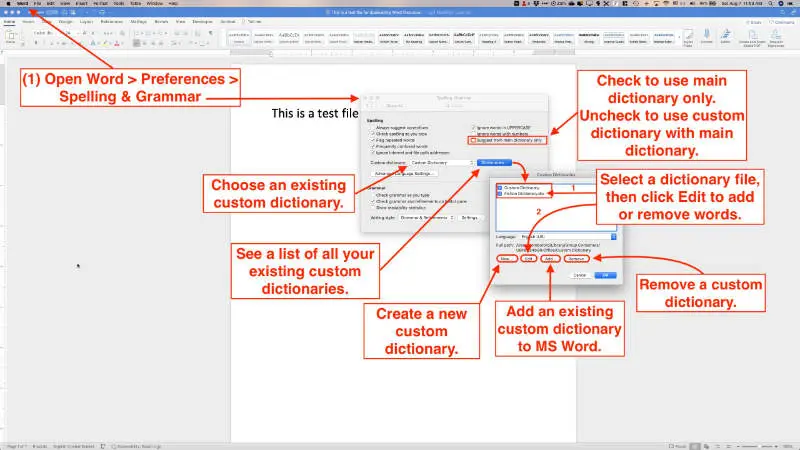
- #How to view custom dictionary in word how to
- #How to view custom dictionary in word full
- #How to view custom dictionary in word windows 10
Open the default.dic file with Notepad and remove any unwanted words.Go to the folder C:\Users\user name\AppData\Roaming\Microsoft\Spelling\your language, for example, C:\Users\winaero\AppData\Roaming\Microsoft\Spelling\en-US.The word will be added to the "default.dic" file.Select Add to dictionary in the context menu.Right click on a highlighted word that is underlined.
#How to view custom dictionary in word windows 10
Add a word to the dictionary in Windows 10 Words stored in the default.exc will be excluded from spell-checking.įinally, the default.acl file stores words for the AutoCorrect word list. The file default.dic stores the words you manually added to the dictionary. Here are the files for the English language: You can type this address to Explorer's location bar to open it directly. They can be found under the folder %AppData%\Microsoft\Spelling. Public class WebService : to view and clear the dictionary contents Dictionary filesįor each language, Windows 10 stores a number of files related to the dictionary. To allow this web service to be called from script, using ASP.NET AJAX, uncomment the following line.
#How to view custom dictionary in word how to
The following C# code provides a simple example of how to write code for an XML web service that returns the result of a dictionary query in the OfficeDefinitions XML format. The following example shows the structure of returned XML that conforms to the OfficeDefinitions schema.
#How to view custom dictionary in word full
Additionally, the URL to the full page on the dictionary site must be provided in the SeeMoreURL element. Returned XML that conforms to the OfficeDefinitions schema consists of a root Result element that contains a Definitions element with from zero to three Definition child elements, each of which contains definitions that are no more than 400 characters in length. The following code shows the XSD for the OfficeDefinitions XML Schema. The following two sections describe the OfficeDefinitions XML schema, and provide an example of how to code an XML web service that returns queries in that XML format. The XML web service must return queries to the web service as XML that conforms to the OfficeDefinitions XML schema. The following sections provide examples of how to create these components. To create a task pane add-in that provides a dictionary lookup, you create two main components:Īn XML web service that looks up definitions from a dictionary service, and then returns those values in an XML format that can be consumed and displayed by the dictionary add-in.Ī task pane add-in that submits the user's current selection to the dictionary web service, displays definitions, and can optionally insert those values into the document. Definitions in the Spelling and Grammar panesįigure 4. Define command in the context menuįigure 3. Figures 3 through 5 show the places in the Office UI where the dictionary XML services are used to provide definitions in Word 2013.įigure 2. It is up to you to determine if clicking the See More link in the dictionary add-in's HTML UI displays more information within the task pane or opens a separate browser window to the full webpage for the selected word or phrase.įigure 2 shows the Define context menu command that enables users to quickly launch installed dictionaries. Dictionary add-in displaying definitions for the selected word The XML web service component returns up to three definitions in the format defined by the OfficeDefinitions XML schema, which are then displayed to the user in other places in the hosting Office application's UI.įigure 1 shows the selection and display experience for a Bing-branded dictionary add-in that is running in Word 2013.įigure 1.

The dictionary provider's webpage then updates to show the definitions for the selection to the user. In a typical dictionary task pane add-in, a user selects a word or phrase in their document, and the JavaScript logic behind the add-in passes this selection to the dictionary provider's XML web service. This article shows you an example of a task pane add-in with an accompanying web service that provides dictionary definitions or thesaurus synonyms for the user's current selection in a Word 2013 document.Ī dictionary Office Add-in is based on the standard task pane add-in with additional features to support querying and displaying definitions from a dictionary XML web service in additional places in the Office application's UI.


 0 kommentar(er)
0 kommentar(er)
